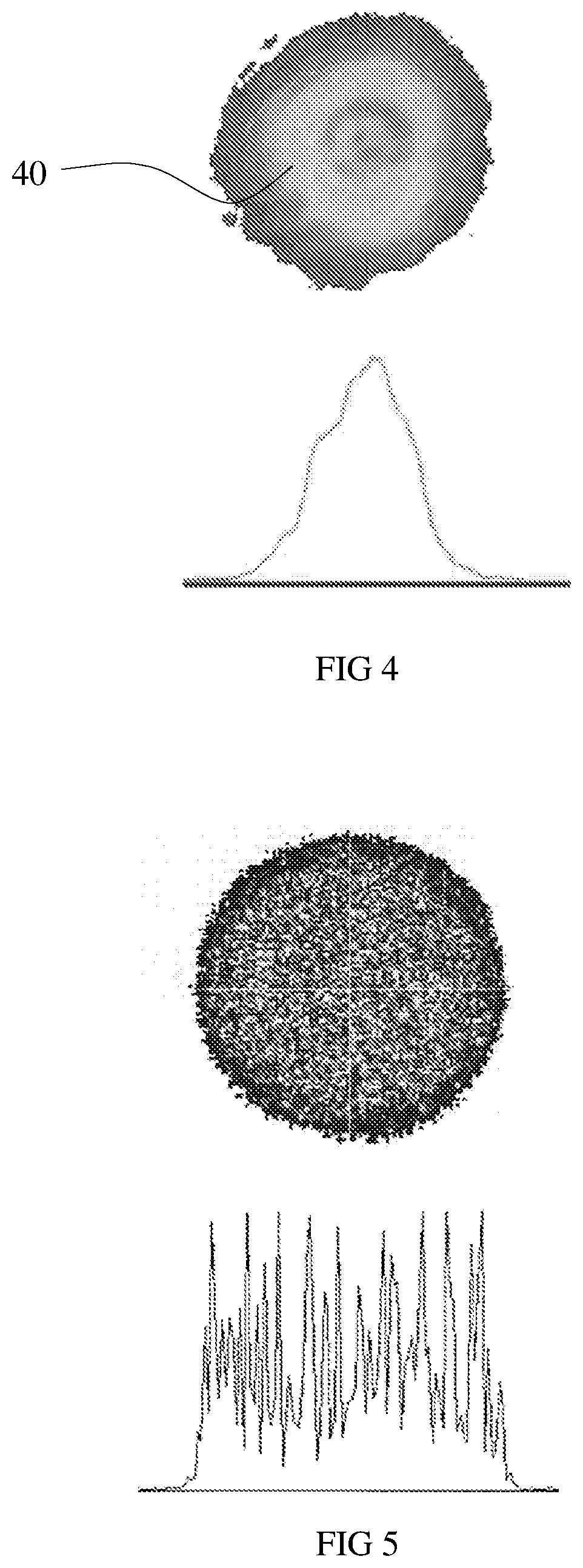Multi-spot ophthalmic laser
a laser and multi-spot technology, applied in the field of laser devices, can solve the problems of thermal shock waves that are detrimental to the regeneration process, too much laser energy, etc., and achieve the effect of high energy intensity spots
- Summary
- Abstract
- Description
- Claims
- Application Information
AI Technical Summary
Benefits of technology
Problems solved by technology
Method used
Image
Examples
first embodiment
[0032]Referring to FIG. 1 there is a shown the invention comprising a multi-spot ophthalmic laser device 10 consisting of a laser module 11, optics 12, multimode fibre 13, coupler 14, multi-fibre bundle 15 and output head 16.
[0033]The laser module may be any suitable laser that generates the appropriate output. The preferred embodiment of the laser module 11 is frequency doubled, Q-switched flashlamp-pumped Nd:YAG laser producing 532 nm laser pulses. The laser cavity is suitably of conventional design having a 100% reflecting end mirror and a partial reflecting output coupler. The laser rod is excited by a flashlamp that is energized by a high voltage power supply. A passive Q-switch allows the cavity energy to be delivered as very short, high energy pulses. An alternate source of excitation is a semiconductor laser that is used to pump the laser rod.
[0034]Although a flashlamp pumped Nd:YAG laser is the preferred embodiment for the laser cavity the invention is not limited to this p...
second embodiment
[0045]the invention is shown in FIG. 10. In this embodiment the optical beam profiling module 100 utilizes a diffractive optical element 101 that modifies the output 11a of the laser module 11 optically to produce multiple spatially distributed laser spots. Looking at FIG. 10 in detail, the laser module output 11a is modified by the diffractive optical element 101 and then focused by a focusing lens 102 to a target 103. The energy peaks at the target 103 have the profile displayed in the enlargement 103a of the target 103 and the graph 104. The diffractive optical element 101 is selected to achieve the energy intensity profile of graph 104 with a spot diameter to space ratio in the range 1:2 to 1:20.
[0046]Three diffractive optical elements 101 have been built to understand the optimal spacing and the optimal spot for the element. The ideal configuration should ensure all neighbouring RPE cells around an individual treated cell remain intact and free of energy absorption. These diffr...
third embodiment
[0047]the invention is shown in FIG. 11. In this embodiment the optical beam profiling module 110 has a masked coating 111 that blocks the undesired parts of the beam 11a and transmits the desired parts of the laser beam 11a. The optical beam profiling module 110 also includes a beam expander / homogenizer 111a that modifies the profile of the beam 11a to have a top hat profile before the mask 111. Looking at FIG. 11 in detail, the laser module output 11a is selectively blocked by the mask 111 and then focused by focusing lens 112 to a target 113. The energy peaks at the target 113 have the profile displayed in the enlargement 113a of the target 113 and the graph 114. The masked coating 111 can partially absorb or reflect the incident light to achieve the energy intensity profile of graph 114 with a spot diameter to space ratio in the range 1:2 to 1:20. In a variation on this embodiment the mask could be applied directly to the focusing lens.
PUM
| Property | Measurement | Unit |
|---|---|---|
| wavelength in the | aaaaa | aaaaa |
| diameter | aaaaa | aaaaa |
| core diameter | aaaaa | aaaaa |
Abstract
Description
Claims
Application Information
 Login to View More
Login to View More - R&D
- Intellectual Property
- Life Sciences
- Materials
- Tech Scout
- Unparalleled Data Quality
- Higher Quality Content
- 60% Fewer Hallucinations
Browse by: Latest US Patents, China's latest patents, Technical Efficacy Thesaurus, Application Domain, Technology Topic, Popular Technical Reports.
© 2025 PatSnap. All rights reserved.Legal|Privacy policy|Modern Slavery Act Transparency Statement|Sitemap|About US| Contact US: help@patsnap.com



